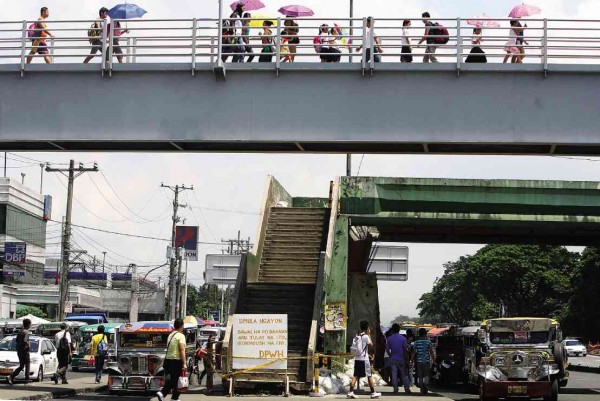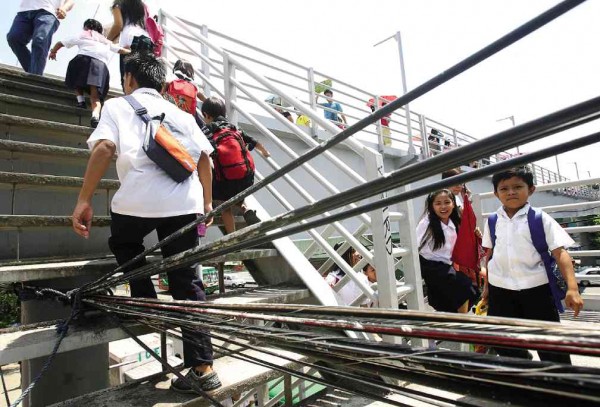QC’s high footbridge is also ‘high-voltage’

NEW AND IMPROVED? A higher but narrower footbridge made of steel (foreground) has replaced the one made of concrete in Quezon City’s Philcoa area. MARIANNE BERMUDEZ
The government spends millions of pesos supposedly to build better infrastructure, or at least make them safer. To make new roads or bridges, for example, private lands are bought, houses are demolished and even trees are uprooted if they stand in the way of development.
But in the case of a new footbridge in Quezon City, the builders apparently found something untouchable: power cables.
The new overhead walkway at the Philcoa area was recently opened to pedestrians, who now not only complain about its height and “voyeur-friendly” stairs—but also the bundle of high-voltage cables that literally passes through between the steps.
The footbridge was obviously built without getting the cables safely out of the way—so it’s up to the people crossing it to watch their step lest they trip or, worse, have an electrifying experience should the live wires be exposed. The hazardous stairs are on the southbound side of Philcoa, near the public market.
The new structure was built a few meters away from the old one, which remains standing but is declared off-limits.
Article continues after this advertisementEden Frago, 49, was almost out of breath after walking up and down the 30-foot-tall steel bridge, which is much higher but narrower than the one it is replacing. “Nakakahingal (It’s really exhausting),” she told the Inquirer on Wednesday.
Article continues after this advertisement“It is really a long walk on a narrow path,” she said, referring to the width of the new bridge, which allows about four persons to walk through side by side with relative ease. End to end, the bridge goes over 14 lanes of Commonwealth Avenue.

SAFETY LAST Pedestrians better watch their step as they encounter this “built-in” hazard, power cables that pass through the stairs of the newly opened Philcoa footbridge. MARIANNE BERMUDEZ
Frago said women wearing skirts would think twice taking the “see-through” stairs. Currently without a lighting system, it may also require extra courage to cross the bridge late at night, she added.
But what worries her more are the power cables. “When it’s dark, you can just trip on them and fall down the stairs. If there is an exposed wire, you can get electrocuted,” she said.
The Inquirer tried to get an explanation from the National Capital Region (NCR) office of the Department of Public Works and Highways (DPWH), but was told that the project engineer, Emmanuel Diaz, was not available for an interview.
But according to a Sept. 30 DPWH-NCR report on the project, the footbridge was supposedly only “75-percent complete” and that work had been suspended pending approval of its “change variation order.”
The report identified Three W Builders as the project contractor, which started work on the structure on Sept. 7, 2012.
It was supposed to be completed in 150 days and had an original budget of P28.7 million that was later revised to nearly P30 million, according to the report.